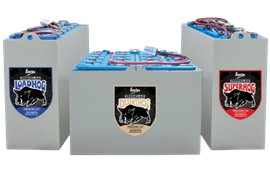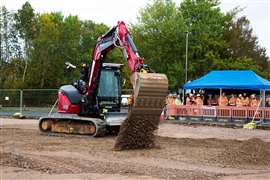Read this article in 中文 Français Deutsch Italiano Português Español
An electric equipment battery primer, part 2: advanced technologies
03 July 2024
Editor’s Note: the following was contributed as an exclusive to Power Progress by battery manufacturer EnerSys, Reading, Pa., and edited for length and style. It is part of a three-part series from EnerSys on understanding battery technology for electric equipment and vehicles.
For the last few decades, concerns about emissions, fuel prices, maintenance costs and overall efficiency have caused battery electric (BE) industrial equipment to steadily replace equipment powered by internal combustion engines (ICEs).
As discussed recently, traditional flooded lead acid batteries have been proven power sources for many industrial applications, such as forklifts and floor care equipment. However, they have some limitations regarding power density and maintenance.
To address these shortcomings, more advanced battery technologies have recently emerged. These include thin plate pure lead (TPPL) and lithium-ion batteries — both of which are becoming increasingly popular for many industrial and e-commerce applications. They can support more demanding applications where traditional lead acid batteries fall short.
By eliminating maintenance and delivering higher performance than traditional flooded lead acid batteries, TPPL and lithium-ion batteries are increasingly becoming the power sources of choice for forklifts, floor care and other utility equipment.
Proven TPPL Technology
Although the TPPL battery is relatively new in industrial vehicle applications, it’s been a proven technology since the 1970s. The 99-percent pure lead plates accelerate energy transfer during shorter charge periods. Meanwhile, the thinner plates provide maximum surface area for faster energy transfer and gains as well as a boost in energy storage density.
 A variety of TPPL batteries. (Photo: EnerSys)
A variety of TPPL batteries. (Photo: EnerSys)
TPPL technology was originally developed for mission-critical military applications that required reliable power and faster charging. As such, these batteries were quickly adopted for material handling and warehousing applications.
Today, TPPL batteries are available in a range of power capacities and configurations. They have slightly higher power density versus flooded lead acid batteries, so they are recommended for light- to medium-duty applications.
The biggest advantages of TPPL batteries are their fast charging abilities and lack of maintenance. For instance, TPPL batteries don’t require watering, washing or long equalizations, making them ideal for fleet owners who want to reduce water consumption and eliminate labor for maintenance.
Additionally, during longer periods of non-use, they typically need to be charged every 6 months without reducing battery life.
Finally, TPPL batteries do not require long charging periods. They can be plugged in whenever the equipment is not in use, such as during breaks, between shifts and at other periods of downtime.
The typical life expectancy of a TPPL battery is 4-5 years, depending on how intensely it is used.
All About Lithium-Ion
While they are a relatively new technology in forklift and floor care equipment applications, lithium-ion batteries are well known for their use in consumer electronics and electric vehicles.
There are multiple approaches to lithium-ion chemistry, with the primary versions used in material handling equipment and industrial applications being lithium iron phosphate (LFP) and nickel manganese cobalt (NMC). The auto industry relies mostly on NMC due to its superior ability to absorb and store energy — providing for faster charging and longer run times between charges.
Lithium-ion batteries are especially well-suited for heavy-duty usage in equipment applications due to their significantly higher charging efficiency over traditional flooded lead acid batteries. Like TPPL, lithium-ion batteries are designed for opportunity charging whenever equipment is not in use. They also do not require routine maintenance, such as adding water or equalization.
However, one of the biggest challenges with using lithium-ion batteries is also what makes them so attractive: their high energy density. This coupled with their elevated energy throughput capability may require more robust electrical infrastructure to support proper charging.
They also require specific controls for safe operation. A battery management system (BMS), which is a small on-board computer designed for the specific battery, typically monitors and controls the battery’s activity. It is essential to lithium-ion battery safety.
Poorly designed lithium-ion batteries with questionable BMS controls have been known to create safety hazards. The best way to avoid these problems is to use a holistically designed system that is composed of the battery, BMS and charger. Also, all system components should be clearly designated as certified by substantiated third-party groups, such as Underwriters Laboratories (UL), Conformité Européenne (CE), the International Organization for Standardization (ISO), and others.
The potential safety risks may cause some insurance providers to refuse coverage or require additional riders, inspections or verifications before insuring a facility using equipment having lithium-ion batteries.
Lithium-ion batteries have a typical life of 5-7 years depending on usage.
Part 3 of this article series will discuss considerations for picking the right battery technologies for different applications.
POWER SOURCING GUIDE
The trusted reference and buyer’s guide for 83 years
The original “desktop search engine,” guiding nearly 10,000 users in more than 90 countries it is the primary reference for specifications and details on all the components that go into engine systems.
Visit Now
STAY CONNECTED




Receive the information you need when you need it through our world-leading magazines, newsletters and daily briefings.
CONNECT WITH THE TEAM















